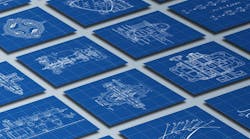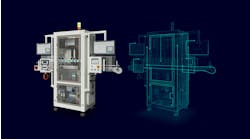Over the years, the focus of my Technology Trends columns has been on the hardware. I draw on my experiences as a man in the trenches to add perspective to the ever-forward march of time and progress. Technology has moved so far in the 34-plus years that I have been in automation that it is hard to imagine doing what we do using the tools that we had back then, but the fact is, we did.
If we remember back to those earlier days, even before the use of programmable controllers, we will find that at its core we had the same basic elements in hand, but they came from an earlier generation. There was still a power supply, relays and contactors, drives and motors, and valves and cylinders. With the introduction of controllers, there was programming software, but, behind all that, at the very base, was a design.
The design was, literally, lines on paper that represented the physical connection of wires to make up a control system. From these simple beginnings, all things became possible. Many of us who have been in the game for a while would say that a design actually starts as a scribble on a napkin over a beverage, and that scribble is born from a need.
The process that takes us from a scribble to a set of prints has changed greatly over the years. I am about to date myself, but I learned how to make electrical schematics with pencil and paper, on a device called a drafting board.
Lines were drawn on the paper using a special drawing tool called a T-square. This was a long straight-edge with a second edge secured at 90º to the long edge. To draw a horizontal line on the page, the T-square is pressed up against the vertical edge of the board and then moved up and down to draw horizontal lines that are parallel to each other.
To draw vertical lines, the T-square is hung across the top of the drawing board and vertical lines are drawn by sliding the square edge along the top edge of the drawing board. To draw lines other than horizontal or vertical, tools called squares are used. The common squares have a 90° angle at one point and either a pair of 45° angles or a 30° and a 60° angle. The squares are rested against the T-square in either the horizontal or vertical orientation to achieve a 30°, 45°, 60° or 90° line from the T-square edge.
Squares can be combined to get other angles. A 45° edge can be combined with the 30/60 square to get 75° or 105°, for example. Design, using the pencil- or pen-to-paper method, also relied on excellent penmanship to apply labels and lettering to the drawing sheet. Generally, lettering was free-form and relied on the designer’s skills to put legible notes on the paper.
As one could imagine, the time invested in creating just a single page in a set of electrical schematics was extensive. Worse yet, since we are human, we are subject to making mistakes. The designer’s best friend was an effective eraser. Any change in design would likely include erasing the previous line and making a new one.
For this reason, plenty of forethought would have to be expended prior to setting pen to paper to reduce the possibility of having to make changes once the design landed on the paper.
Speaking of paper, early electrical design also had to consider who was going to be using the finished set. In most cases, there was more than one individual or group that would have a need to see the prints, and, for that reason, methods of reproduction would have to be considered.
Drawings generally need to be seen from a bit of a distance—arm’s length or more—so page sizes must be larger and the information on that page must be easily read from further away.
Common sizes of 18x24-in (B-size) 24x36-in (C-size) and 36x48-in (D-size) were in use. Since multiple copies of a drawing set were necessary, processes were followed that allowed for reproduction by a method called blueprinting. This was a contact printing process where the design is laid down on light-sensitive sheets. First invented in 1842, the process would produce white lines on a blue background, essentially a negative of the original, thus giving the finished product the description of a blueprint. By this means, an infinite number of reproductions could be produced.
The main challenge to producing originals on light-sensitive paper was the relatively fragile nature of the paper. Handling it repeatedly would lead to rips and tears and a general deterioration of the media.
A new method was introduced to use a product called vellum. Vellum has been around for hundreds of years. A translucent media type, the earliest version of vellum was stretched animal skin or a membrane of some type. To write on vellum, one scrapes away the surface of the membrane to etch the information onto the media.
As technology has progressed, variations on the paper and vellum methods led to ink on a synthetic vellum and lettering sets that were used in conjunction with the T-square to produce mechanically improved letters on a drawing.
Regardless of the improvements, these methods of creating engineered designs on drawing sets was a long, drawn-out process. Fortunately, like every aspect of our control designs, the means by which to get a drawing set produced has benefitted from the march of technology.
The biggest boon to control design came in the guise of personal computers, particularly those utilizing a graphical user interface. With the use of computers came the prospect of computer-aided design (CAD). Early CAD software ran on mainframe computers, but, with the advent of the personal (desktop) computer, CAD came to the forefront.
The most popular CAD software today is AutoCAD, but other software packages have been released over the years, each with a niche market segment in mind. Names such as Microstation, first released in the mid-1980s; SolidWorks, mid-1990s; CATIA; FastCAD; and many others, including open—free—versions exist today. Regardless of your favorite version, CAD software is here to stay, and every new version aims to make the designer’s job easier and quicker with greater accuracy.
Most of the CAD platforms mentioned above have base versions—2D or 3D—that accomplish basic electronic drafting, but the best part of these packages is the add-on kits that bring enhanced functionality to the basic package.
These kits have specialized menus and functions that are specific to the type of project that the user is working on. Examples of this include mechanical, electrical, architectural, HVAC and MEP (mechanical, electrical and piping). Of particular interest to a control designer is the electrical package.
With my favorite CAD package, I am able to create and manage sheet sets. I can define templates for the various types of drawings that I produce. I have a standardized layer definition that I use across all of my drawing sets. Individual pages or groups of pages can easily be extracted from an already complete drawing set to create a new set, saving a great deal of time by using a library of designs.
Specific information on the drawing set—such as project or customer name, sheet numbers, date created or revised—can be globally updated instead of opening up each drawing and revising each one separately.
Drawings created by other vendors or companies can be imported into a drawing set and then standard items such as layers and colors, terminology, naming and numbering conventions can be applied to the drawings in the set.
While all of the above sounds exciting, it is the collaboration of CAD vendors and hardware vendors that has really enhanced the design process. Most major CAD vendors have included libraries of components by most of the popular hardware vendors. So, instead of just inserting a normally open push button on my electrical schematic, I can provide further information—at insertion or at a later date—to assign the actual part number to the object on the screen, or page.
This method is very handy because it automatically assigns not only the part number, but also the terminal designations and ratings for that particular device into the database that is the drawing and set. An example of where this is very useful would be the insertion of a control relay. Perhaps at the outset of my design, I just need a single-pole control relay with a 24 Vdc coil. I select one from my favorite vendor and move on with my design.
The software program automatically assigns the terminal designations as defined by the manufacturer and not only the relay coil but the contact terminals, as well. By selecting the coil or the contact, once inserted, the software will bring up a summary of the device and what contacts have been used and what are still available.
Inserting additional contacts will automatically assign the terminal designations, and the software will notify the designer if the relay no longer has any available contacts. With a click of a couple of selections, the designer can choose another relay with more contacts on it, and the software will automatically update the database in the drawing to reflect the selection of a different component.
Common with all CAD software programs, each drawing is a searchable file that contains information about all of the components on the page and drawing set at a whole. Designer tools in the software create reports of the components in use in the drawing sets, and cross-reference reports can be generated to show where all the components exist.
Here is where things have gotten interesting the past few years. While discipline-specific designer kits are available, the ability to combine disciplines has come to reality. Starting with an electrical schematic, the designer can also design the control-panel layouts, using mechanical design kit and then, in the best part of all this, can insert mechanical components in the panel layout.
The software will automatically add the component to the electrical schematic database. Further, once the link is established, the software will also take a component on the electrical schematic and add it to the panel-layout database. Any component added to one drawing set becomes part of a selection list for the other set. The advantage here is that the designer doesn’t have to keep track of additions at design time because the software keeps track for them.
Conducting an audit at any time in the design process will reveal items that are in one database and that aren’t inserted on a drawing in the other drawing set or sets.
Computer-aided-design has taken that sketch on a napkin into a realm that is hard to imagine. It would be nearly impossible to design control systems without the use of CAD software, and the modular aspects of drawing sets created electronically has dramatically reduced the amount of time needed to bring a design to life. How did we ever live without it?






